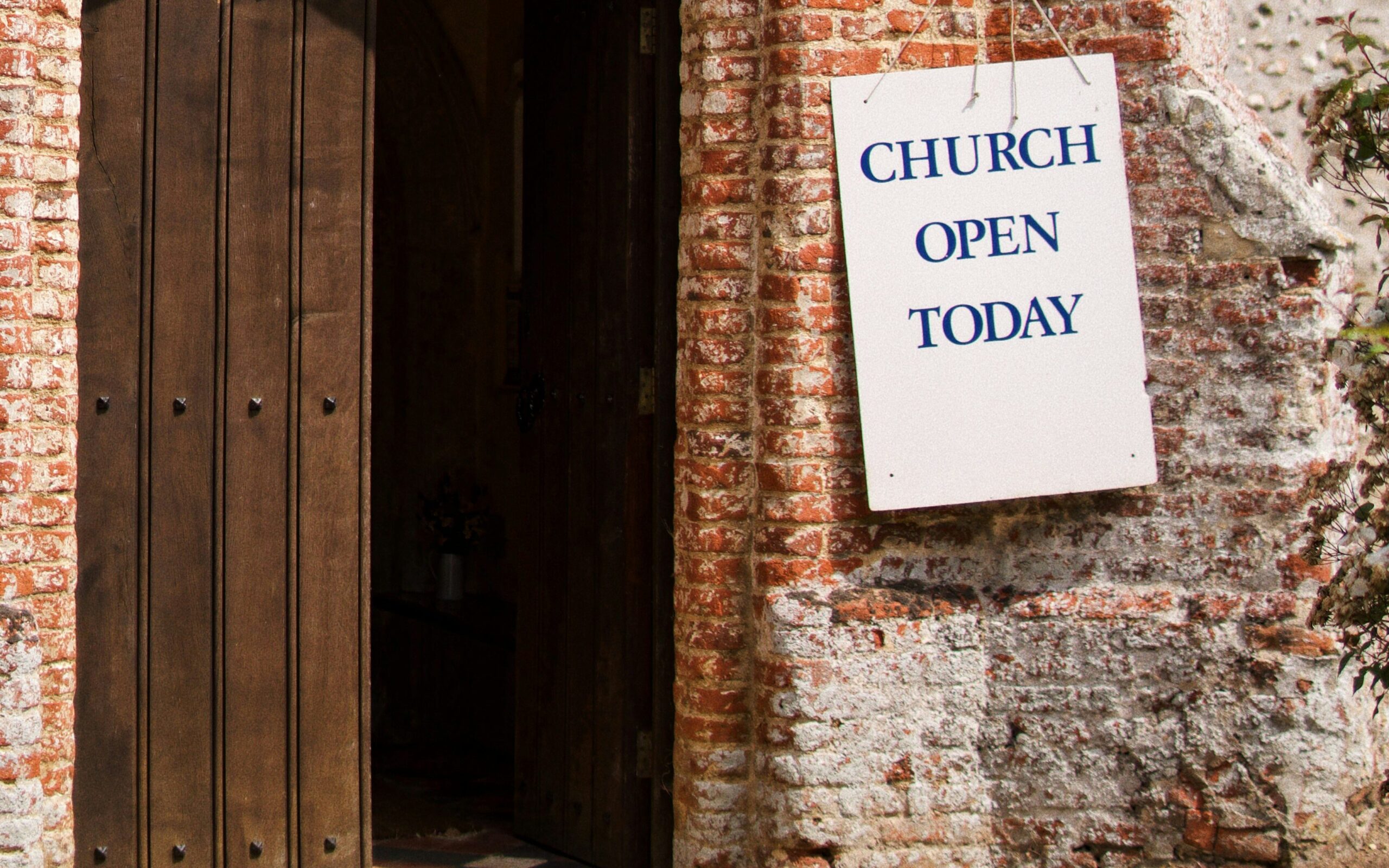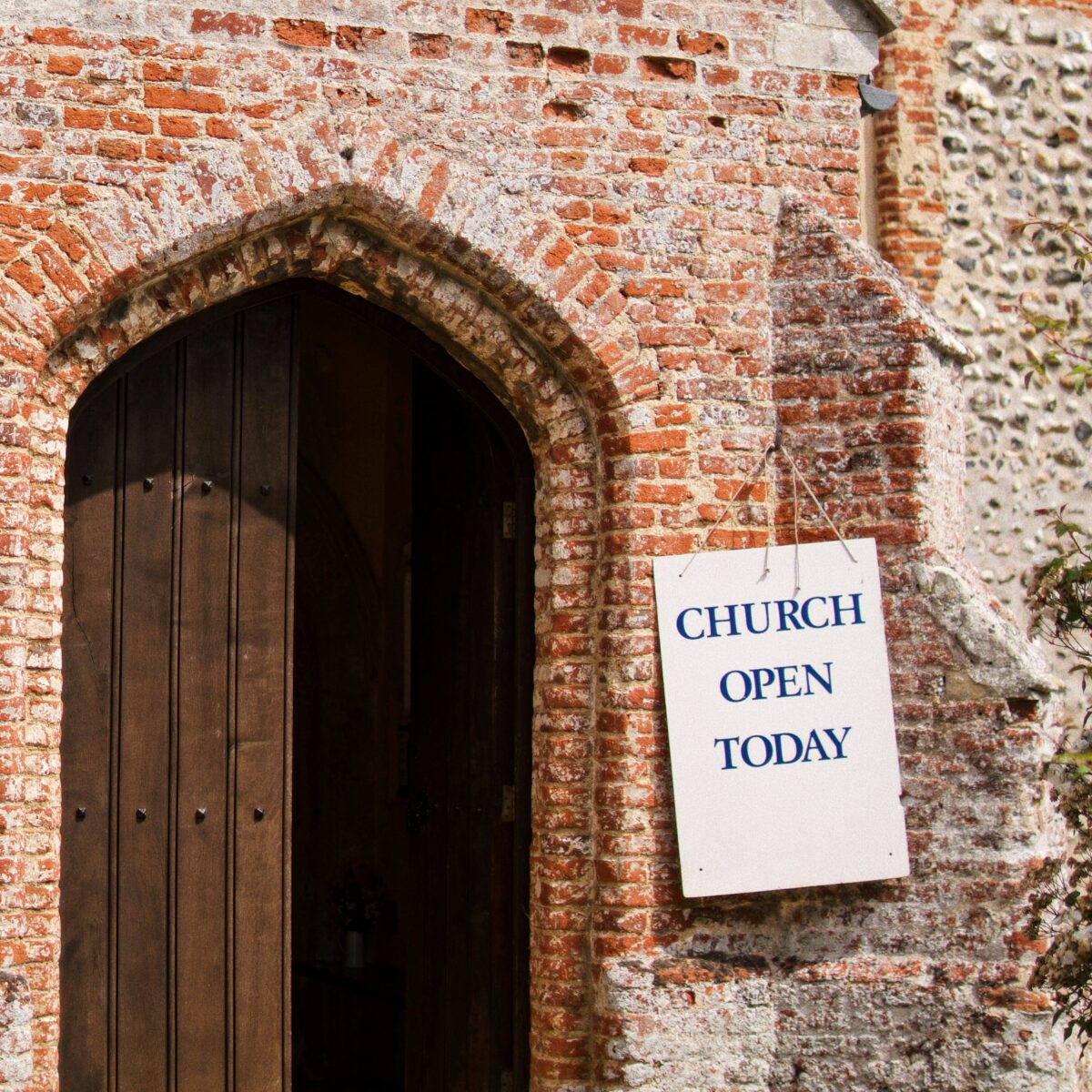
Always Open
Why churches should open their doors
In a time of crisis and confusion, a church can be a place of refuge from the noise and a source of inspiration. But Phil McCarthy finds too many churches are keeping their doors closed. In his work to promote walking pilgrimage, Phil hikes across England and Wales and finds the welcome of an open church to fulfil an important role in the rebuilding of our common life.
When I see some little church here, in this city, or when I see it in another diocese where I go, with its doors closed, that’s a bad sign. Churches must always have their doors open because this is a symbol of what a church is: always open. The Church is called to always be the open house of the Father. So that, if someone wants to follow a movement of the Spirit and approaches looking for God, they will not find themselves coming face to face with the coldness of a closed door. [1] Pope Francis
Over the last year I have been walking pilgrim ways between Catholic cathedrals and one or more shrines within the same diocese. Sadly I come ‘face to face with the coldness of a closed door’ at many of the Catholic churches enroute, and even some of our cathedrals. If you are a weary pilgrim hoping to experience the church, light a candle and say a prayer, a bolted church door is a disappointment. An open door can be the high point of the day. I have found that Anglican places of worship are more likely to be open.
As Pope Francis points out, as well as being physical structures, doors are metaphors. An open church provides a welcome to those is search of God, but a locked church sends seekers a clear message: “Keep out: this is private space.” Francis has written of pilgrims:
Whoever they may be — young or old, rich or poor, sick and troubled or curious tourists — let them find due welcome, because in every person there is a heart in search of God, at times without being fully aware of it.[2]
Whether we walk or not, we all have ‘a heart in search of God’. A friend recently told me that as a young man he was at a moment of crisis. He walked into a church and sat down. That twenty minutes of silent reflection changed his life. He later came to faith and has taken up important lay roles in the Church. He believes that if the church door had been locked, his life might have taken a very different direction.
A church with an open door is a witness to shared faith and an evangelical presence in its neighbourhood. Churches fulfil important roles for the common good of the community in times of crisis, as we saw in the wake of the Grenfell Tower fire. And in ordinary times, churches can be important places of refuge from the noise and relentless busyness of everyday life. A few moments of silence and stillness can transform a person’s day, even for a confirmed atheist.
On my walks I have come across open churches which provide examples of what can be done. In the Diocese of Clifton there is St James’ Priory next to Bristol Bus & Coach Station. The Church does not have a resident priest, but it is open daily for Eucharistic adoration. I have witnessed how well this opportunity is taken up. Despite the city centre location, thefts and acts of vandalism are rare and, when they occur, minor. In deep countryside I visited the isolated Church of St Thomas, Claughton in the Diocese of Lancaster. There was a notice inviting visitors into the presence of the Blessed Sacrament, incense in the air and recorded plainsong. The church provided welcome and spiritual uplift. The experience of visiting churches can be enhanced by making printed prayers available or by providing a notice with QR codes for sites like Universalis and the Jesuit Pray As You Go app so that people can easily access prayer resources and the readings of the day on their phones.
The potential benefits are great, and it can be done, so why are the doors of so many churches locked? In my view part of the problem is that many Christians tend to have a utilitarian view of their churches, seeing no need to open them except when a service is being held. The architectural styles of churches built (necessarily cheaply) after World War II may reinforce this. Spires may point to the heavens, reminding us of the transcendence of God, but the sanctuary light beside the tabernacle is a sign of the immanence of God, as present for us in the most modest 1960’s prefab church as in a great cathedral.
In this post Christendom age, churches with open doors are important signals of an apostolic spirit, openness to the neighbourhood, engagement in the life of the local community, and a demonstration of God’s abundant love and generosity.
Nevertheless church leaders and pastoral councils need to manage the practicalities, and many will be aware of cautionary stories. Parishes must balance personal safety and protecting property with being a sacred presence in their neighbourhood. The Catholic Insurance Service advises that there are no additional premiums for extended church opening hours, and Ecclesiastical, the main insurer of Church of England churches, actually encourages them to be open. This implies that open doors do not significantly increase the risk of claims. Here are some practical steps to mitigate risks and avoid potential problems:
*Electronic security can protect the sanctuary from unwanted incursions and a safe can be installed for smaller financially or religiously valuable objects.
*Some churches provide daytime access using a keypad lock. The code can be given to people who ask to visit without the need for someone to physically unlock the doors. At night the church can be locked more securely.
*It may be possible to allow access to the narthex and to provide a kneeler and prayer resources in this area.
*In many parishes there will be lay people prepared to organise and participate in a rota to unlock and lock church doors. In the early Church there was a lay ministry of the ostiary (usher) who opened the doors and received people. This could be revived.
*For my part I encourage pilgrims who wish to visit churches on one of my pilgrim ways to check the parish website or phone the office in advance, and to remember that a single priest may be covering several churches and that he or she may live many miles away.
*The National Churches Trust is a useful source of advice and information.
We may not be hiding our sanctuary lights under bushels, but too often they are concealed by fearfully locked doors. This does not present a spiritual confidence or a welcoming face to a society in desperate need of meaning and hope.
It is a widespread belief that the churches are in decline, and certainly this is undeniable in certain places. But there is also evidence of growth, and with 66% of UK adults saying they think that churches are important for society (according to a December 2023 opinion poll[3]), closed doors risk alienating people from the Church at a time when it is most needed.
There are some inspiring prompts to encourage your local church to open its doors. The Catholic Church, for example, will be celebrating a Jubilee year in 2025 when the Holy Doors of the great Roman basilicas will be opened in an invitation to the world, setting a tone that could be echoed by the local church. Dioceses are producing resources to encourage churches to open their doors, for example, the Diocese of Ely’s Visitor Welcome Toolkit.
And whether it is through new synodal practices being adopted by Catholics, or through a renewed desire to forge better local relationships among all denominations, Christians can demonstrate a spirit of openness. Churches can offer the local community a place of encounter, an experience of the sacred for seekers and a place of rest for the occasional footsore pilgrim!
© Phil McCarthy
Phil McCarthy is a retired GP, former CEO of Caritas Social Action Network, and Project Lead of the Hearts in Search of God pilgrim ways project. Discover a wealth of pilgrimage resources at his website here: pilgrimways.org.uk
Notes:
[1] https://www.vatican.va/content/francesco/en/audiences/2019/documents/papa-francesco_20191023_udienza-generale.html
[2] https://www.vatican.va/content/francesco/en/speeches/2016/january/documents/papa-francesco_20160121_giubileo-operatori-santuari.html
[3] Attitudes to Church Buildings (2023-2024) https://www.nationalchurchestrust.org/news/our-research
This story is featured in the Easter 2024 edition of the T4CG Newsletter.

